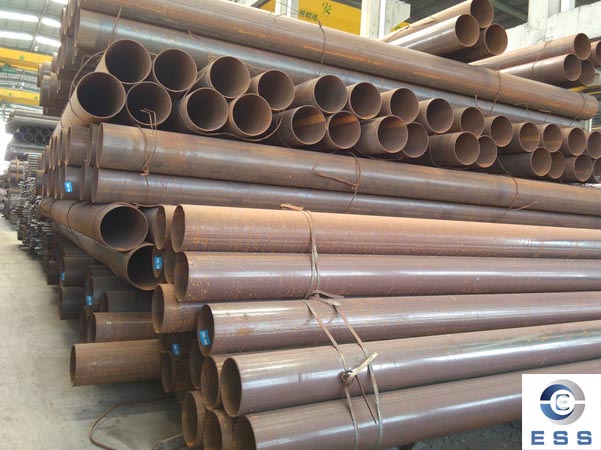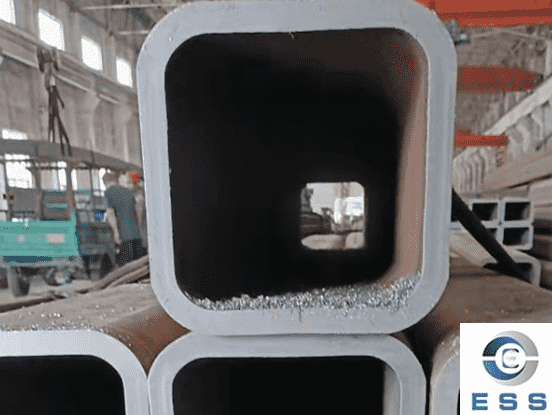ERW pipe is made by using the skin effect and proximity effect of high-frequency current to rapidly heat the edge of the tube blank to the welding temperature, and then extrude and weld it. Compared with seamless steel pipes, ERW steel pipes have the advantages of high dimensional accuracy, low price, and high production efficiency, and their grain size and structure density are superior to
seamless steel pipes; compared with submerged arc welded pipes of the same specification, ERW steel pipes have faster production speed , There is no local thinning of the anti-corrosion layer at the weld. Its application fields involve casing for oil drilling, subsea oil and gas transmission pipes for offshore oil industry, oil and gas transmission pipes and gas distribution pipes for trunk lines and urban pipeline networks.
There may be a variety of welding defects in ERW steel pipes, some of which come from the base metal, and some are generated during the welding process. Different defects have different effects on welding quality. Regional defects such as cracks and lack of fusion are prone to stress concentration under stress conditions, which is the main cause of low-stress brittle fracture of welds; while volume defects such as pores and slag inclusions are less sensitive to cracking than surface defects. , but the effective cross-sectional area of the weld is reduced, and the strength of the weld is reduced. Under the action of external force, these defects often become the source of cracks, which eventually lead to cracking of the weld.

Ultrasonic testing in the production process of ERW steel pipes:
Ultrasonic testing is currently the main non-destructive testing method in the production process of ERW welded pipes. Its main application fields include: 1) Ultrasonic online detection of steel plates. 2) Ultrasonic online detection of weld seam after ERW welding to remove internal and external burrs. 3) Off-line detection of ERW welds. 4) Ultrasonic flaw detection of ERW welded pipe ends.
1. Ultrasonic online detection of steel plate
Ultrasonic on-line detection of steel plates generally uses twin-crystal or poly-crystal probes, plus water film or partial water immersion, and its main purpose is to detect layered defects in the steel plate parallel to the surface of the steel plate. There are two main scanning methods: one is to scan parallel lines along the rolling direction; the other is that the steel plate moves linearly along the rolling direction, and the probe reciprocates perpendicular to the moving direction of the steel pipe to form a "Z" shape scan. Since the edge of the steel plate forms the weld seam in the subsequent ERW welding, the defect detection at this position is particularly important in the ultrasonic inspection of the steel plate. Relevant standards and specifications require 100% scanning of the edge of the steel plate. In actual work, the method of increasing the number of probes at the edge of the steel plate is generally adopted to ensure this.
2. Ultrasonic online detection of weld seam
The ultrasonic on-line inspection of ERW welds is carried out after welding and removing internal and external burrs. It mainly includes two parts: one is to detect internal and external burrs through A-scan or B-scan. Scratch effect. Compared with A-scan, B-scan can display the appearance of the inner wall of the weld after removing the internal burr in real time, and the graphic display is more intuitive; the second is oblique incidence of longitudinal waves, and the shear waves generated by refraction in the welded pipe are used to detect welding defects. Due to the high temperature of the weld seam at this time, the high temperature probe is generally used for online detection and partial immersion in water.
3. Ultrasonic off-line detection of welding seam and pipe end detection
Off-line ultrasonic testing of ERW welds is generally performed after hydrostatic testing and chamfering, and is mainly used to detect longitudinal defects in welds and heat-affected zones. In order to improve detection efficiency, automatic detection is generally adopted. Due to the influence of the pipe end dead zone in automatic detection. This is usually followed by manual ultrasonic scanning of the weld. The content of pipe end inspection mainly includes the detection of pipe end weld, pipe end parent metal delamination defects, axial and circumferential defects. The detection of delamination defects generally adopts split probes. The oblique probe scanning method is mostly used for circumferential defects.
Read more: ERW Pipe Specifications and Models or Seamless pipe vs erw pipe













 Eastern Steel Manufacturing Co.,Ltd not only improve product production and sales services, but also provide additional value-added services. As long as you need, we can complete your specific needs together.
Eastern Steel Manufacturing Co.,Ltd not only improve product production and sales services, but also provide additional value-added services. As long as you need, we can complete your specific needs together.










